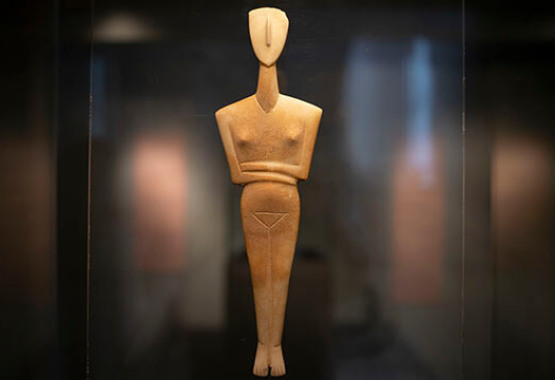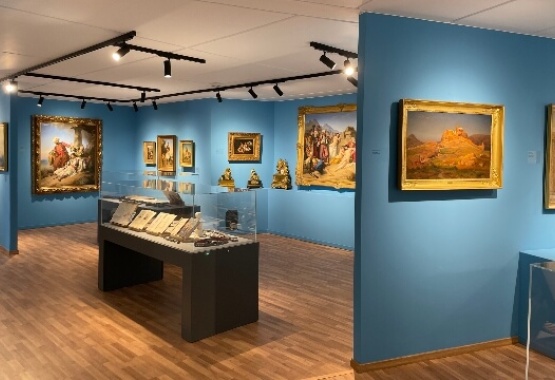
ATHENS
Museum History
The National Historical Museum was established by the Historical and Ethnological Society of Greece* in 1884. The foundation of the Society is inextricably linked with its first official public appearance, with the “Exhibition of Memorials of the Sacred Struggle”, two years later. In this exhibition, in response to an appeal by the Society, the families of the fighters of the Revolution of 1821 and government bodies, such as the Ministries of War and Navy, provided exhibits that were in their possession. Most of these objects, at the end of the exhibition, were donated to the Museum of the Historical and Ethnological Society, as was its first name, thus becoming its central core. Since then, the Museum operated for the public for over half a century in the halls of the Athens Polytechnic. On the eve of the Second World War, as a measure of precaution, the items were packaged and hidden in the basement of the Polytechnic and in private rooms. After the war strong efforts were made to find adequate accommodation. Since 1960 the Museum is permanently housed in the Old Parliament on Stadiou Street (Kolokotronis Square).
Permanent Exhibition
Τhe permanent exhibition of the National Historical Museum narrates the history of Hellenism from the fall of Constantinople (1453) till the Greek-Italian War of 1940-1941, through paintings and engravings, flags and weapons from national liberation struggles, personal items of historical figures, documents and photographs, utensils and tools as well as traditional costumes and works of modern Greek craftsmanship.
NHM Annexes in Hydra
In 1979 Pantelis Koundouriotis, descendant of the Hydriot notable Lazaros Koundouriotis, bequeaths to the Society his family mansion on Hydra island with the prospect of turning it into a museum.Since 2001 the Lazaros Koundouriotis Historic Residence operates as part of the National Historical Museum, a major local attraction for numerous visitors.
In 2007, the Athens Academy member, painter Panagiotis Tetsis (Hydra island, 1925 – Athens, 2016) donated his grandparents’ home on Hydra Island to the Historical and Ethnological Society of Greece, in order for it to become after his passing a museum housing his works and studio. The Tetsis Home & Workshop is open to all visitors, upon request, in cooperation with the personnel of the Lazaros Koundouriotis Historic Mansion (LKHM).
*The Historical and Ethnological Society of Greece
The Historical and Ethnological Society of Greece was founded in 1882, at a time of economic and social advancement of the Greek state, about fifty years after its independence. Founding members of the Society were eminent scholars and scientists of the time. The Society aimed at collecting, preserving and promoting the relics and testimonies that illuminate the history of Modern Greece. To accomplish this goal, the Society immediately set up the Museum, Archive and Library. Since 1883, it published the Bulletin of the Historical and Ethnological Society of Greece, containing scientific articles on history and ethnography.
National Historic Museum
The Museum narrates the history of Modern Greece
The National Historical Museum is permanently housed in the Old Parliament Building at Stadiou Street (Kolokotronis square). The Museum narrates the history of Modern Greece: the period of Ottoman and Latin rule, the Greek War of Independence (1821), the liberation struggles, the creation of an independent state, the political, social and spiritual development of the Greeks up to the present day.Museum History
The National Historical Museum was established by the Historical and Ethnological Society of Greece* in 1884. The foundation of the Society is inextricably linked with its first official public appearance, with the “Exhibition of Memorials of the Sacred Struggle”, two years later. In this exhibition, in response to an appeal by the Society, the families of the fighters of the Revolution of 1821 and government bodies, such as the Ministries of War and Navy, provided exhibits that were in their possession. Most of these objects, at the end of the exhibition, were donated to the Museum of the Historical and Ethnological Society, as was its first name, thus becoming its central core. Since then, the Museum operated for the public for over half a century in the halls of the Athens Polytechnic. On the eve of the Second World War, as a measure of precaution, the items were packaged and hidden in the basement of the Polytechnic and in private rooms. After the war strong efforts were made to find adequate accommodation. Since 1960 the Museum is permanently housed in the Old Parliament on Stadiou Street (Kolokotronis Square).
Permanent Exhibition
Τhe permanent exhibition of the National Historical Museum narrates the history of Hellenism from the fall of Constantinople (1453) till the Greek-Italian War of 1940-1941, through paintings and engravings, flags and weapons from national liberation struggles, personal items of historical figures, documents and photographs, utensils and tools as well as traditional costumes and works of modern Greek craftsmanship.
NHM Annexes in Hydra
In 1979 Pantelis Koundouriotis, descendant of the Hydriot notable Lazaros Koundouriotis, bequeaths to the Society his family mansion on Hydra island with the prospect of turning it into a museum.Since 2001 the Lazaros Koundouriotis Historic Residence operates as part of the National Historical Museum, a major local attraction for numerous visitors.
In 2007, the Athens Academy member, painter Panagiotis Tetsis (Hydra island, 1925 – Athens, 2016) donated his grandparents’ home on Hydra Island to the Historical and Ethnological Society of Greece, in order for it to become after his passing a museum housing his works and studio. The Tetsis Home & Workshop is open to all visitors, upon request, in cooperation with the personnel of the Lazaros Koundouriotis Historic Mansion (LKHM).
*The Historical and Ethnological Society of Greece
The Historical and Ethnological Society of Greece was founded in 1882, at a time of economic and social advancement of the Greek state, about fifty years after its independence. Founding members of the Society were eminent scholars and scientists of the time. The Society aimed at collecting, preserving and promoting the relics and testimonies that illuminate the history of Modern Greece. To accomplish this goal, the Society immediately set up the Museum, Archive and Library. Since 1883, it published the Bulletin of the Historical and Ethnological Society of Greece, containing scientific articles on history and ethnography.




